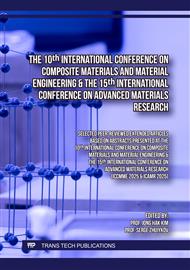[1]
Projet FILLTECH Fillers calcaires: quel avenir dans les bétons?, CSTC, le Centre 'Terre et Pierre' et le département ArGEnCo de l'Université de Liège, Publications: CSTC-Contact, no. 19. (2008).
Google Scholar
[2]
Menadi, B., Kenai, S., Khatib, J., & Aït-Mokhtar, A. Strength and durability of concrete incorporating crushed limestone sand. Construction and Building Materials, 23(2), 625–633. https://doi.org/10.1016/j.conbuildmat.2008.02.005. (2009).
DOI: 10.1016/j.conbuildmat.2008.02.005
Google Scholar
[3]
Wang, D., Shi, C., Farzadnia, N., Shi, Z. and Jia, H., 2018. A review on effects of limestone powder on the properties of concrete. Construction and building materials, 192, pp.153-166.
DOI: 10.1016/j.conbuildmat.2018.10.119
Google Scholar
[4]
Wang, D., Shi, C., Farzadnia, N., Shi, Z., Jia, H. and Ou, Z., 2018. A review on use of limestone powder in cement-based materials: Mechanism, hydration and microstructures. Construction and Building Materials, 181, pp.659-672.
DOI: 10.1016/j.conbuildmat.2018.06.075
Google Scholar
[5]
Panesar, D.K. and Zhang, R., 2020. Performance comparison of cement replacing materials in concrete: Limestone fillers and supplementary cementing materials–A review. Construction and building materials, 251, p.118866.
DOI: 10.1016/j.conbuildmat.2020.118866
Google Scholar
[6]
Benabed, B., Soualhi, H., Belaidi, A.S.E., Azzouz, L. and Kenai, S., 2016. Effect of limestone powder as a partial replacement of crushed quarry sand on properties of self-compacting repair mortars. Journal of Building Materials and Structures, 3(1), pp.15-30.
DOI: 10.34118/jbms.v3i1.21
Google Scholar
[7]
Benabed, B., Kadri, E.H., Azzouz, L. and Kenai, S., 2012. Properties of self-compacting mortar made with various types of sand. Cement and Concrete Composites, 34(10), pp.1167-1173 [5] GCAA. Limestone filler. GCCA. https://gccassociation.org/cement-and-concrete-innovation/clinker-substitutes/limestone-filler/ (2020).
DOI: 10.1016/j.cemconcomp.2012.07.007
Google Scholar
[8]
Benjeddou, O., Soussi, C., Jedidi, M. and Benali, M., 2017. Experimental and theoretical study of the effect of the particle size of limestone fillers on the rheology of self-compacting concrete. Journal of Building Engineering, 10, pp.32-41.
DOI: 10.1016/j.jobe.2017.02.003
Google Scholar
[9]
Samchenko, S., Larsen, O. and Gurkin, A., 2019. The effect of dispersion of limestone on the properties of cement mortar. Materials Today: Proceedings, 19, pp.2068-2071.
DOI: 10.1016/j.matpr.2019.07.076
Google Scholar
[10]
Murmu, A.L. and Patel, A., 2018. Towards sustainable bricks production: An overview. Construction and building materials, 165, pp.112-125.
DOI: 10.1016/j.conbuildmat.2018.01.038
Google Scholar
[11]
Bouharoun, S., Leklou, N., & Mounanga, P. Use of asbestos-free fiber-cement waste as a partial substitute of Portland cement in mortar. Materials and Structures, 48(6), 1679–1687. https://doi.org/10.1617/s11527-014-0264-0. (2014).
DOI: 10.1617/s11527-014-0264-0
Google Scholar
[12]
Dale, P. B., Edgardo, F. I., Brooks, E. B., & Weiss, W. J. Limestone fillers conserve cement - TSAPPS at NIST. https://tsapps.nist.gov/. https://tsapps.nist.gov/publication/ get_pdf.cfm?pub_id=901137. (2009).
Google Scholar
[13]
ASTM (D422), "Standard Test Method for Particle Size Analysis," ASTM International (2007).
Google Scholar
[14]
CYS EN 1015-33:1999. Methods of test for mortar for masonry – Part 3: Determination of consistence of fresh mortar (by flow table).
DOI: 10.3403/01541440
Google Scholar
[15]
CYS EN 1015-11:2019. Methods of test for mortar for masonry Determination of flexural and compressive strength of hardened mortar (2019).
DOI: 10.3403/01905442
Google Scholar
[16]
CYS EN 1936:2006. Natural stone test methods. Determination of real density and apparent density, and of total and open porosity (2006).
DOI: 10.3403/30149240
Google Scholar
[17]
CYS EN 1925:1999. Natural stone test methods. Determination of water absorption coefficient by capillarity (1999).
Google Scholar



